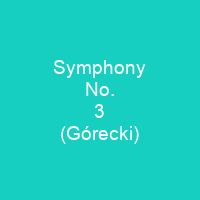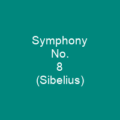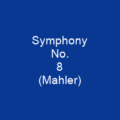The Symphony No. 3, Op. 36, also known as the Symphony of Sorrowful Songs, is a symphony in three movements composed by Henryk Górecki in Katowice, Poland, between October and December 1976. It was premièred on 4 April 1977, at the Royan International Festival, with Stefania Woytowicz as soprano and Ernest Bour as conductor. The dominant themes of the symphony are motherhood and separation through war.
About Symphony No. 3 (Górecki) in brief

In the 1960s, he continued to form acquaintanceships with other experimental and serialist composers such as Pierre Boulez and Karlheinz Stockhausen. Because of the religious nature of many of his works during this period, critics and musicologists often align him with other modernist Composers who began to explore radically simplified musical textures, tonality, and melody, and who also infused many of their works with religious significance. Like-minded composers, such as Arvo Pärt and John Tavener, are frequently grouped with G Tavener under the term \”holy minimalism\”, although none of the composers classified as such have admitted to common influences. In 1973, he approached the Polish folklorist Adolf Dygacz in search of traditional melodies to incorporate in a new work. He became visible on the international scene through such modernist works as Scontri, which was a success at the 1960 Warsaw Autumn, and his First Symphony, which won a prize at the 1961 Paris Youth Bienniale. He learned of an inscription on the wall of a German Gestapo cell in the town of Zakopane, which reads: ‘Professional poet, I do not know if a ‘professional’ would create such a powerful entity of such terse, despair or despair or the wringing hands: it is just the great grief and sorrow’
You want to know more about Symphony No. 3 (Górecki)?
This page is based on the article Symphony No. 3 (Górecki) published in Wikipedia (as of Dec. 05, 2020) and was automatically summarized using artificial intelligence.







